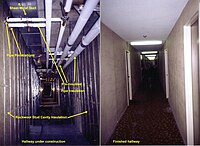
Photo from wikipedia
Abstract Various thermal prediction methods and tools for conceptual building design have been rapidly developed in the past decades. However, most of these methods have some drawbacks to obsess their… Click to show full abstract
Abstract Various thermal prediction methods and tools for conceptual building design have been rapidly developed in the past decades. However, most of these methods have some drawbacks to obsess their applications, such as heavily relying on very detailed information of building envelope components, and their thermal conductivity data with complicated computation models or formulas; and difficulties for architects to understand and judge the outcomes of such predictions in a conceptual design. Therefore, this research targets on developing a simplified method to predict the integrated thermal performance of a building with simplified envelope parameters and hourly free-running temperatures in the conceptual design stage. It categorizes the scattered design parameters into three combined thermal characteristic indexes and applies a serials of corresponding quasi-steady calculation methods for building thermal processes to predict hourly free-running temperatures. The interrelationships between these three combined indexes and two overall thermal performance indicators are verified via a sensitivity analysis, and are presented in two charts, which can easily be adopted in a conceptual building design. This method has been validated in an experimental case study. It can help architects to quickly find the thermal design performance of a designed building in the conceptual design stage.
Journal Title: Journal of building engineering
Year Published: 2020
Link to full text (if available)
Share on Social Media: Sign Up to like & get
recommendations!